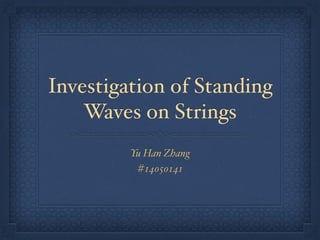
Physics LO - Investigation of Standing Waves on Strings
- 1. Investigation of Standing Waves on Strings Yu Han Zhang #14050141
- 2. What are Standing Waves Standing waves are produced by repeated interference of 2 waves with identical frequency, wavelength, and amplitude while moving in opposite directions.
- 3. Characteristics of Standing Waves Nodes and anti-nodes are produced as a result of standing waves. Node: points on the string that have 0 amplitude and remain at rest at all times. Nodes are caused by destructive interference of the 2 waves Anti-node: points that move with the maximum amplitude (twice the original amplitude of each wave). Anti-nodes are caused by constructive interference of the 2 waves
- 4. Patterns of Standing Waves From the table, we can deduce some relationships between wavelength and harmonic number; we can also find patterns of number of nodes and anti-nodes and conclude how they are related to the harmonic number
- 6. Note that the harmonic number m can only be positive integers e.g. 1,2,3,4…
- 7. Multiple Choice 1 Now we have sufficient knowledge about standing waves, let us try some questions. Start with some simple multiple choice questions 1. You can decrease the frequency of a standing wave on a string by: A. making the string longer B. using a thicker string. C. decreasing the tension. D. all of the above.
- 8. Answer: D.All of the above A. making the string longer - this works because as the formula suggests: if length increases, frequency decreases B. using a thicker string - this works because thicker string means heavier mass, so linear mass density μ will decrease; as a result, frequency decreases C. decreasing tension - works because if T decreases, as the formula suggest, frequency will decrease
- 9. Multiple Choice 2 A guitar string has a length of 60 cm and a linear mass density of 0.01kg/m. If the string is put under tension of 60N. Determine the frequency of the third harmonic generated in the guitar string in Hz. A. 194Hz B. 222Hz C. 137 Hz D. 245 Hz E. 173 Hz
- 10. Answer: A. 194Hz We are given the information that it is third harmonic, so m= 3 String length L = 60cm = 0.60 m (remember to convert to meters) μ = 0.01 kg/m T = 60 N; so plug in the formula
- 11. Now we have gained some skills in solving basic problems. Let us do a more in-depth problem
- 12. Multi-Part Problem A 100.0cm string is vibrating with both sides clamped. The string is kept under the tension of 25.00N. The linear mass density is 0.650g/m a) What is the lowest frequency standing wave possible on this string? b) What are the frequencies of the second and third harmonics c) Can a standing wave of frequency 1.5 times the frequency calculated in part a) be generated on this string without changing the length / tension? d) What is the wave speed of the string?
- 13. a) What is the lowest frequency standing wave possible on this string? In order to approach this problem, the formulas needed are listed above. For a) the question is asking for the lowest frequency. Looking at the formula, since T ,L and µ are given and we cannot change their values, the only way to manipulate the value of frequency is by changing the harmonic number m. So the lowest frequency is achieved when m =1 μ = 0.650g/m = 0.00065kg/m (remember to convert to the standard unit) L = 100.0cm = 1.000m and T = 25.00N Plug these numbers into the first formula, we obtain the following result Solution to a)
- 14. b) What are the frequencies of the second and third harmonics For the second harmonics, only the harmonic number changes to 2, so plug the numbers into formula 1, we get For the third harmonics, the harmonic number changes to 3, so plug numbers into formula 1 we get Solution to b)
- 15. c) Can a standing wave of frequency 1.5 times the frequency calculated in part a) be generated on this string without changing the length / tension? The answer is NO. It is tempted to just jump into the calculation and plug numbers into the formula. However, since we know that harmonic numbers can only be positive integers 1,2,3… it is impossible to get a frequency 1.5 times the fundamental frequency. Solution to c)
- 16. d) What is the wave speed of the string? In order to figure out the speed, we need frequency and wavelength. We have already obtained the fundamental frequency in the first question as 98.1Hz. Now we need to figure out the wavelength corresponds to the harmonic wave when m=1. Solution to d)
- 17. Note that we do not have to use the fundamental frequency from part a). We can use the frequency of the the second and third harmonics as long as we use the correct wavelength corresponds to the right harmonic number E.g. For the second harmonic, we will use m = 2 in the equation to figure out the wavelength. As a result, you would get the same result that v = 196m/s Alternative Solution to d)
- 18. Sources All of the equations are typed into a word document and the screenshot is used since keynote does not support equations The chart is created by myself with images used from http://physics.info/waves-standing/
- 19. Thank You